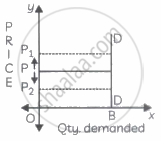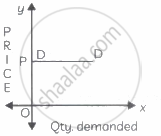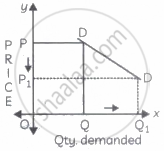HSC Commerce (English Medium)
HSC Science (General)
HSC Arts (English Medium)
HSC Science (Electronics)
HSC Science (Computer Science)
HSC Commerce: Marketing and Salesmanship
Academic Year: 2021-2022
Date & Time: 19th March 2022, 3:00 pm
Duration: 3h30m
Advertisements
Notes:
- All questions are compulsory.
- Draw neat tables/diagrams wherever necessary.
- Figures to the right indicate full marks.
- Write answers to all main questions on new page.
Complete the correlation:
Macro Economics : ______ :: Micro Economics : Price theory.
Chapter: [0.01] Introduction to Micro and Macro Economics [1.01] Introduction to Micro Economics
Complete the correlation.
Direct demand : Food and Mobiles : ______ : Land and Labour.
Chapter: [0.031] Demand Analysis [1.03] Analysis of Demand and Elasticity of Demand
Complete the correlation.
Perfectly elastic demand : Ed = ∞ :: ______ : Ed = 1.
Chapter: [0.032] Elasticity of Demand
Complete the correlation.
Output method : Product method :: ______ : Factor cost method.
Chapter: [0.07] National Income
Complete the correlation.
Personal Income tax : ______ :: Goods and service tax (GST) : Indirect tax.
Chapter: [0.08] Public Finance in India
Give economic terms:
Additional utility derived by a consumer from an additional unit consumed.
Chapter: [0.02] Utility Analysis
Give economic terms.
Price being constant, demand falls due to unfavourable changes in other factors.
Chapter: [0.031] Demand Analysis [1.03] Analysis of Demand and Elasticity of Demand
Give economic terms.
Revenue per unit of output sold.
Chapter: [0.04] Supply Analysis
Give economic terms:
The period in which all factors of production are variable.
Chapter: [0.05] Forms of Market
Give economic terms:
The gross market value of all final goods and services produced within the domestic territory of a country during a period of a year.
Chapter: [0.07] National Income
The whole economy is studied in ______
Micro Economics
Macro Economics
Econometrics
Natural Sciences
Chapter: [0.01] Introduction to Micro and Macro Economics
When the percentage change in quantity demanded is Less than the percentage change in price the demand curve is ______
Flatter
Steeper
Rectangular hyperbola
Horizontal
Chapter: [0.032] Elasticity of Demand
The cost incurred by the firm to promote sales ______
Total cost
Average cost
Marginal cost
Selling cost
Chapter: [0.04] Supply Analysis
The budget consists of revenue receipts and revenue expenditure ______
Capital budget
Government budget
Revenue budget
Family budget
Chapter: [0.08] Public Finance in India
Purchase of goods and services from one country and selling them to another country is ______
Entrepot trade
Import trade
Export trade
National trade
Chapter: [0.1] Foreign Trade of India
Advertisements
Assertion and reasoning question:
- Assertion (A): Marginal utility (MU) goes on diminishing.
- Reasoning (R): Total utility (TU) increases at a diminishing rate.
Assertion (A) is true but Reasoning (R) is false.
Assertion (A) is false but Reasoning (R) is true.
Both statements (A) and (R) are true and R is the correct explanation of (A).
Both statements (A) and (R) are true and R is not the correct explanation of (A).
Chapter: [0.02] Utility Analysis
Assertion and reasoning question:
- Assertion (A): With a rising price, the supply of a commodity falls.
- Reasoning(R): Seller earns more profit at a higher price.
Assertion (A) is true but Reasoning (R) is false.
Assertion (A) is false but Reasoning (R) is true.
Both statements (A) and (R) are true and (R) is the correct explanation of (A).
Both statements (A) and (R) are true and (R) is not the correct explanation of (A).
Chapter: [0.05] Forms of Market
Assertion and reasoning question:
- Assertion (A): The index number considers all factors.
- Reasoning (R): The index number is based on samples.
Assertion (A) is true but Reasoning (R) is false.
Assertion (A) is false but Reasoning (R) is true.
Both statements (A) and (R) are true and (R) is the correct explanation of (A).
Both statements (A) and (R) are true and (R) is not the correct explanation of (A).
Chapter: [0.06] Index Numbers
Assertion and reasoning question:
- Assertion (A): The money market economises the use of cash.
- Reasoning (R): The money market does not deal with financial instruments that are close substitutes for money.
Assertion (A) is true but Reasoning (R) is false.
Assertion (A) is false but Reasoning (R) is true.
Both statements A and R are true and R is the correct explanation of A.
Both statements A and R are true and R is not the correct explanation of A.
Chapter: [0.09] Money Market and Capital Market in India
Assertion and reasoning question:
- Assertion (A): International trade leads to the division of labour and specialization.
- Reasoning (R): India's national trade is not increasing.
Assertion (A) is true but Reasoning (R) is false.
Assertion (A) is false but Reasoning (R) is true.
Both statements A and R are true and R is the correct explanation of A.
Both statements A and R are true and R is not the correct explanation of A.
Chapter: [0.1] Foreign Trade of India
Identify and explain the following concept.
Asha collected information about the income of a particular firm.
Chapter: [0.01] Introduction to Micro and Macro Economics [1.01] Introduction to Micro Economics
Identify and explain the following concept.
Ramesh's demand for salt remained unchanged lnspite of a 10% rise in its price.
Chapter: [0.032] Elasticity of Demand
Identify and explain the following concept.
Out of 4000 kgs of rice, the farmer offered to sale 1000 kgs of rice in the market for ₹ 40 per kg.
Chapter: [0.04] Supply Analysis
Identify and explain the following concept.
Shobha collected data regarding the money value of all final goods and services produced in the country for the financial year 2019-20.
Chapter: [0.07] National Income [2.02] National Income
Identify and explain the following concept.
Lucy deposited a Lump sum amount of ₹1,00,000/- in the Bonk of India for the period of one year.
Chapter: [0.09] Money Market and Capital Market in India
Distinguish Between
Slicing method and Lumping method
Chapter: [0.01] Introduction to Micro and Macro Economics
Distinguish between:
Joint/complementary demand and competitive demand.
Chapter: [0.031] Demand Analysis [1.03] Analysis of Demand and Elasticity of Demand
Distinguish between:
Total revenue and marginal revenue
Chapter: [0.04] Supply Analysis
Distinguish between:
Price Index and Quantity Index.
Chapter: [0.06] Index Numbers
Distinguish between internal debt and external debt.
Chapter: [0.08] Public Finance in India
Explain the scope of Macro economics.
Chapter: [0.01] Introduction to Micro and Macro Economics
Advertisements
Explain any four features of monopoly
Chapter: [0.05] Forms of Market
Explain any four features of utility.
Chapter: [0.02] Utility Analysis
Write any four practical difficulties in national income estimation.
Chapter: [0.07] National Income
Explain the Ratio method of measuring price elasticity of demand.
Chapter: [0.032] Elasticity of Demand
State with reasons whether you agree or disagree with the following statement.
There are no exceptions to the law of diminishing marginal utility.
Agree
Disagree
Chapter: [0.02] Utility Analysis
State with reason whether you agree or disagree with the following statement:
The supply curve of labour is backward bending.
Agree
Disagree
Chapter: [0.04] Supply Analysis
State with reasons whether you agree or disagree with the following statement.
Price under perfect competition is decided by the interaction between demand and supply.
Agree
Disagree
Chapter: [0.05] Forms of Market
State with reasons whether you agree or disagree with the following statement.
The capital market plays an important role in India.
Agree
Disagree
Chapter: [0.09] Money Market and Capital Market in India
State with reasons whether you agree or disagree with the following statement.
The balance of Payment is the same as the Balance of Trade.
Agree
Disagree
Chapter: [0.1] Foreign Trade of India
Study the following table and answer the questions given below it.
| Components | ₹ Crores |
| Consumption (C) | 800/- |
| Investment (I) | 700/- |
| Government Expenditure (G) | 400/- |
| Net Export (X-M) | -150/- |
| Depreciation (D) | 100/- |
- Calculate GDP (Gross Domestic Product) on the basis of the above table.
- Calculate NDP (Net Domestic Product) on the basis of the above table.
Chapter: [0.07] National Income
Study the following figure and answer the question given below it.
Identify the price elasticity of demand from the following diagram:

Perfectly inelastic demand
Perfectly elastic demand
Relatively inelastic demand
Relatively elastic demand/unitary elastic
Chapter: [0.032] Elasticity of Demand
Study the following figure and answer the question given below it.
Identify the price elasticity of demand from the following diagram:

Perfectly inelastic demand
Perfectly elastic demand
Relatively inelastic demand
Relatively elastic demand/unitary elastic
Chapter: [0.032] Elasticity of Demand
Study the following figure and answer the question given below it.
Identify the price elasticity of demand from the following diagram:

Perfectly inelastic demand
Perfectly elastic demand
Relatively inelastic demand
Relatively elastic demand/unitary elastic
Chapter: [0.032] Elasticity of Demand
Study the following figure and answer the question given below it.
Identify the price elasticity of demand from the following diagram:

Perfectly inelastic demand
Perfectly elastic demand
Relatively inelastic demand
Relatively elastic demand/unitary elastic
Chapter: [0.032] Elasticity of Demand
Study the following table, figure, and passage, and answer the questions given below it.
| Commercial banks act as intermediaries in the country's financial system to bring savers and investors together. They are profit-seeking financial institutions. Due to bank nationalisation in 1969, there was an increase in Loan disbursement in urban and rural areas. Agriculture and retail traders started getting more loons. Those sectors which were not getting Loons before 1969, started getting loons in post nationalisation period. After the nationalisation of the bank branch expansion took place. There has been diversification in the functions of banks. Commercial Banks are providing different types of services like safe deposit lockers, D-mat facilities, internet banking, mobile banking, etc. |
- Write any two benefits of bank nationalisation.
- Write various services provided by banks.
- Write your opinion about the above passage.
Chapter: [0.09] Money Market and Capital Market in India
Explain the concepts of variation and changes in demand with the help of diagrams.
Chapter: [0.031] Demand Analysis
Explain the meaning of index number.
Chapter: [0.06] Index Numbers
Explain the steps involved in the construction of index numbers.
Chapter: [0.06] Index Numbers
Explain various sources of public revenue.
Chapter: [0.08] Public Finance in India
Submit Question Paper
Help us maintain new question papers on Shaalaa.com, so we can continue to help studentsonly jpg, png and pdf files
Maharashtra State Board previous year question papers 12th Standard Board Exam Economics with solutions 2021 - 2022
Previous year Question paper for Maharashtra State Board 12th Standard Board Exam Eco-2022 is solved by experts. Solved question papers gives you the chance to check yourself after your mock test.
By referring the question paper Solutions for Economics, you can scale your preparation level and work on your weak areas. It will also help the candidates in developing the time-management skills. Practice makes perfect, and there is no better way to practice than to attempt previous year question paper solutions of Maharashtra State Board 12th Standard Board Exam.
How Maharashtra State Board 12th Standard Board Exam Question Paper solutions Help Students ?
• Question paper solutions for Economics will helps students to prepare for exam.
• Question paper with answer will boost students confidence in exam time and also give you an idea About the important questions and topics to be prepared for the board exam.
• For finding solution of question papers no need to refer so multiple sources like textbook or guides.
